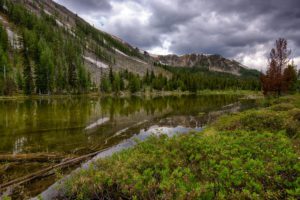For Immediate Release
February 10, 2023
Contact:
Roger Dobson, Protect the WolvesTM, (714) 750-6878, roger@protectthewolves.com
Erik Molvar, Western Watersheds Project, (307) 399-7910, emolvar@westernwatersheds.org
HAILEY, Ida. – A new study shows that wolves living inside National Parks – protected from killing and harassment by humans – suffer a high chance of social disruption and pack disintegration due to human-caused deaths outside Park boundaries. Across five National Parks (Yellowstone, Grand Teton, Voyageurs, Yukon-Charley, and Denali), 82% of wolves that died of human causes over the past 35 years died were at the hands of trophy hunting and state and federal agencies’ officially-sanctioned killing outside Park boundaries. As a result, National Park wolf packs had a 20% chance of losing a pack member each year, and packs that lost at least one member to human causes had a 23.7% chance of disintegrating entirely. In some cases, entire packs were wiped out, according to the research.
“Clearly, the National Park Service is unable to protect wolves living inside National Parks from depredations that occur from wolf hunters and wildlife-killing agencies outside their borders,” said Erik Molvar, a wildlife biologist and Executive Director with Western Watersheds Project. “Excessively permissive hunting and trapping policies by anti-wolf state governments, and federal and state agencies eager to kill wolves to appease the livestock industry and soothe irrational and unfounded fears of rural local residents, are to blame.”
Of the five National Parks, Yellowstone and Grand Teton had the highest proportion of their wolves killed by humans. In 2022 (after the study was completed), hunters killed 23 Yellowstone National Park wolves, mostly in Montana, out of a population estimated at 95 wolves by the National Park Service in December 2021.
Indigenous leaders have long called for wolf protections. In 2017, Protect the Wolves, an Indigenous-led wolf advocacy group, officially petitioned the state governments of Montana, Wyoming, and Idaho to create a Sacred Resource Protection Zone to ban wolf hunting and trapping within 50 kilometers (31 miles) of Yellowstone and Grand Teton National Parks. Numerous tribal groups have signed an international Wolf Treaty, which recognizes a sacred relationship between wolves and Indigenous peoples, criticizes trophy hunting and lethal control in response to livestock losses, and calls for further expanded recovery of wolf populations with connectivity linkages in currently unoccupied parts of their historic range.
“The state governments should have listened to Indigenous voices and created this Sacred Resource Protection Zone around Yellowstone and Grand Teton National Parks, to prevent the killing of National Park wolves,” said Roger Dobson, a Cowlitz Tribal Member and Director of Tribal Cultural Resources with Protect the Wolves. “In this new study, we now have definitive proof that the failure of state governments to protect wolves on the lands surrounding Yellowstone and Grand Teton are causing serious unnatural disruptions for wolf packs, and preventing these wolves from living out their lives in a natural and undisturbed way.”
Yet state governments ignored the Indigenous-led petition to prevent wolf killing in the lands surrounding Yellowstone and Grand Teton. In the new study, killing one of the two “alpha wolves,” the breeding pair that leads each pack, decreased the odds of pack persistence to the next breeding season by 73%. The groups are now placing the onus on the Biden administration to halt the killing.
“State governments in Idaho, Montana, and Wyoming have had their chance to grant National Park wolves a zone of protection around these National Parks, but they were irresponsible, and ramped up wolf-killing instead,” said Molvar. “Now it’s time for the federal government to step up and end the killing by listing these wolves under the Endangered Species Act, which would put an end to hunting and trapping of these National Park wolves, and further restrict agency killings.”
“The killing of wolves and disruption of wolf packs living in in Yellowstone and Grand Teton National Parks is completely unnecessary and preventable, and the federal government should step in to prevent it,” said Dobson. “It is imperative that government agencies including fish and game departments begin to recognize our sacred cultural beliefs, like the beliefs of all other religions, and our special relationship to the species that Native Americans hold as sacred.”
While the study also noted a decrease in successful reproduction in those particular wolf packs suffering human-caused losses, other research has found that the disintegration of wolf packs can result in compensatory increase in breeding to fill the gap. However, in Yellowstone, wolf predation on bison – the most difficult prey for wolves to catch – might go down as a result of pack dissolution and prey switching to easier prey like elk. Scientific research shows that wolf-elk-bison interactions are complex, his alteration of predator-prey dynamics could interfere with the ecological recovery of Yellowstone that has been accomplished as a result of wolf reintroduction.
###






